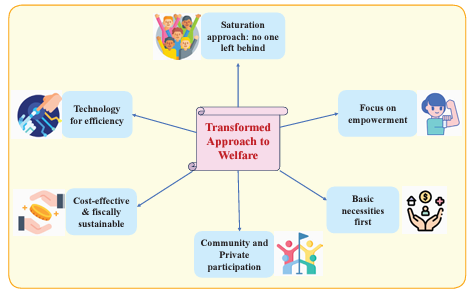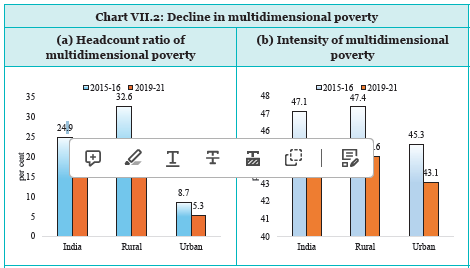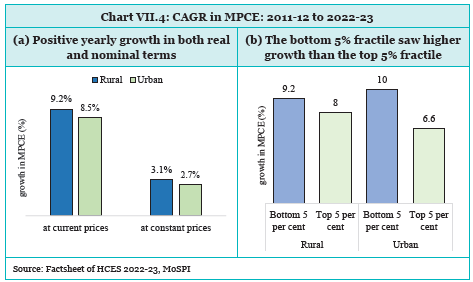Chapter 7- SOCIAL SECTOR: BENEFITS THAT EMPOWER
India’s recent economic growth is marked by social and institutional progress through effective government programs in health, education, sanitation, digital empowerment, and rural quality of life. Women-led development and digital rural governance have improved living standards. Achieving developed country status by 2047 requires efficient programs, state initiatives, and community participation.
Introduction
- Introduction
- Dovetailing Growth with Empowering Welfare: a paradigm shift
- Transformative Welfare Approach in India
- Overall Progress and Outcomes
- Improvements in multidimensional poverty
- India’s Progress in MPI: 2019-21 vs. 2015-16
- Household Consumption Expenditure Survey 2022-23
- Quality Healthcare for All
- Education
- Progress in School Infrastructure
- Way Forward in Education:
- India making headway in R&D
- SOCIAL AND ECONOMIC EMPOWERMENT OF WOMEN
- Social empowerment of women
- Economic empowerment of women
- RURAL ECONOMY: DRIVING THE GROWTH ENGINE
- Enhancing the quality of Life in Rural Areas:
- Strengthening and modernising the safety net of MGNREGS
- Rural Governance: A story of digital transformations at the grassroots
- Conclusion and Way Forward
India aims to become a developed nation by 2047 through comprehensive economic, social, technological, and institutional progress. Significant advancements in health, education, and infrastructure have been made, driven by increasing government social sector expenditure. From FY18 to FY24, overall welfare expenditure grew at a CAGR of 12.8%, with health and education seeing notable increases.

Dovetailing Growth with Empowering Welfare: a paradigm shift
India’s social and economic milieu presents many strengths, opportunities, and challenges. India’s growth as the fifth-largest economy has improved citizens’ lives through government welfare programs, including gas connections, toilets, bank accounts, houses, tap water, and healthcare. The young population offers opportunities for progress, but challenges like education, malnutrition, and disparities remain. A long-term, empowering welfare approach is crucial for inclusive growth, enhancing self-esteem and participation in development.
Transformative Welfare Approach in India
Focus on Efficiency and Technology
India’s new welfare approach emphasizes efficient implementation and effectiveness of government programs to maximize impact per rupee spent. As Muralidharan (2024) suggests, improving the efficiency of converting spending into outcomes is crucial for addressing issues like child stunting and improving school learning. The government is focusing on process reforms, accountability, and technology utilization to enhance cost-effectiveness.
Digitization and Direct Benefit Transfers
Digitization in healthcare, education, and governance has multiplied the impact of welfare spending. The Direct Benefit Transfer (DBT) scheme and the JAM trinity (Jan Dhan Yojana-Aadhaar-Mobile) have transferred over ₹38 lakh crore since 2013, boosting fiscal efficiency and minimizing leakages.
Outcome-Oriented Budgeting
The government has adopted a goal-oriented budgeting approach, linking budgetary allocations to expected outputs and outcomes. NITI Aayog’s Output-Outcome Monitoring Framework tracks central schemes, promoting transparency and accountability through real-time monitoring.
Targeted Implementation and Social Programs
Programs like the Aspirational Districts Programme (ADP), Aspirational Blocks Programme, Vibrant Villages Programme, and Viksit Bharat Sankalp Yatra focus on last-mile service delivery, improving health, nutrition, education, and infrastructure in underserved areas. Investments in health and sanitation, such as Mission Indradhanush and Swachh Bharat Mission, have increased vaccination rates and reduced disease incidence.
Social Security for Unorganized Sector
The government has introduced affordable social security schemes for unorganized sector workers, including Atal Pension Yojana (APY), PM Jeevan Jyoti Yojana (PMJJY), and PM Suraksha Bima Yojana (PMSBY), expanding the social safety net.
Corporate Social Responsibility (CSR)
Since 2014, mandatory CSR spending by companies has supported sustainable and inclusive development. Corporate profits and the CSR pool are expected to grow, further accelerating development with non-profits’ grassroots presence.
Overall Progress and Outcomes
Improvements in multidimensional poverty
Income alone does not fully capture poverty, making the measurement of multidimensional poverty crucial. India’s National Multidimensional Poverty Index (MPI), aligned with the global MPI and customized by NITI Aayog, assesses poverty through health, education, and standard of living across 12 indicators, measuring both incidence and intensity of poverty.
India’s Progress in MPI: 2019-21 vs. 2015-16

NITI Aayog’s paper reveals that 24.82 crore people escaped multidimensional poverty in India between 2013-14 and 2022-23, with poverty dropping from 29.17% to 11.28%. Uttar Pradesh saw the largest decline, followed by Bihar, Madhya Pradesh, and Rajasthan. The poverty reduction rate accelerated significantly between 2015-16 and 2019-21.
Household Consumption Expenditure Survey 2022-23

The Household Consumption Expenditure Survey (HCES) 2022-23 shows reduced inequality and increased consumption spending, with rural MPCE rising 40% and urban MPCE 33.5% since 2011-12. The Gini coefficient declined, and the rural-urban divide lessened. Consumption growth among the lowest 5% outpaced the top 5%, highlighting inclusive economic growth despite COVID-19 challenges.
Quality Healthcare for All
| Programme/Purpose (year of launch) | Progress/Outcome |
|
Ayushman Bharat Pradhan Mantri Jan Aarogya Yojana (AB-PMJAY) (2018) Health insurance cover of ₹5 lakh/ year for underprivileged families for secondary and tertiary hospitalisation |
|
| PM Jan Aushadhi Kendras Quality medicines at 50-90 per cent cheaper than market rates |
|
| AMRIT (Affordable Medicines and Reliable Implants for Treatment) Subsidised medicines for critical illnesses | More than 300 Amrit pharmacies operating in different States/UTs |
| Ayushman Bhav Campaign (Sep 2023) To saturate selected healthcare services in every village/town and inform citizens about the Government’s flagship schemes. |
|
| eSanjeevani (2019) for telemedicine |
|
Stock of the Mental Health Scenario
Importance and Rising Issues
Mental health is crucial for overall well-being, impacting physical, social, and emotional health. WHO data indicates one in eight people globally had a mental disorder in 2019, with a significant rise due to COVID-19. In India, 10.6% of adults suffer from mental disorders.
Children and Youth
Mental health issues among children and adolescents are rising due to academic pressure, social media, and family dynamics. NCERT reports increasing anxiety and mood swings among students, exacerbated by COVID-19.
Economic Impact
Mental health disorders lead to productivity losses and increased healthcare costs. Investment in mental health yields high returns, with significant economic and health benefits.
Policy Initiatives
India’s policies, including the National Mental Health Policy (2014) and National Education Policy (2020), emphasize mental health, with 22 disorders covered under Ayushman Bharat – PMJAY health insurance.
Education
The UN’s SDG4 aims for inclusive, equitable education and lifelong learning for all by 2030. India’s National Education Policy (NEP) 2020, now in its fourth year, aligns with these goals, focusing on enhancing school education quality for 26 crore students, aiming to establish India as a global knowledge superpower. The NEP addresses learning gaps exacerbated by COVID, emphasizing foundational skills and holistic education approaches.
| Poshan Bhi Padhai Bhi’: Pre-schools network anchored in Anganwadis | ||||||||||
|
||||||||||
| Vidyanjali: A school volunteer programme | ||||||||||
|
Initiated on September 7, 2021, the Vidyanjali programme has significantly advanced school education quality in India by fostering community involvement, corporate social responsibility, and private sector contributions. It operates through a dedicated portal connecting volunteers from diverse backgrounds to schools, where they introduce innovative teaching methods and resources. As of 2024, the program has onboarded over 747,000 schools and registered nearly 459,000 volunteers, impacting over 14.4 million children by enhancing educational environments and facilities across the nation.
|
Progress in School Infrastructure
Basic facilities in schools continued to improve in FY 23 over earlier years. Toilets (girls or boys), drinking water, and hand-washing facilities are now available in most Government schools. Priority to drinking water and sanitation in schools under the Samagra Shiksha Scheme and the Swachh Bharat Mission have been instrumental in this.
National Curriculum Framework for School Education (NCF-SE) 2023
Launched in August 2023, the NCF-SE 2023, created by a 12-member committee with input from 1.6 million stakeholders, enhances the NCF-2005 by promoting competency-based and vocational education from grade 3, focusing on Indian languages, and integrating Indigenous knowledge and technology to improve foundational literacy and numeracy.
Vocational Education
- The NEP 2020 emphasizes vocational education in all institutions, starting from foundational stages, focusing on local job opportunities and skills gaps. The Samagra Shiksha Scheme supports infrastructure, teacher training, and curriculum development.
- From FY19 to FY24, 29,342 schools covered skill education, encompassing 88 job roles in 22 sectors. FY24 saw the introduction of 25 new job roles under the Hub and Spoke model. For FY25, skill education exposure is approved for 1,08,418 schools, benefiting over 3.6 million students with employability skills.
Higher Education:
Female enrolment has increased to 31.6% since FY15. The growing equity in higher education implies better employment opportunities for the hitherto backward sections.
Re-imagining lifelong learning through a digital prism
- India’s educational landscape includes 26.52 crore school students, 4.33 crore in higher education, and over 11 crore in skilling institutions, supported by 14.89 lakh schools and 1,168 universities. The NEP 2020 aims to transform this ecosystem, promoting lifelong learning and interconnected, multidisciplinary education.
- The National Credit Framework (NCrF), launched in April 2023, underpins this vision with digital solutions like APAAR and ABC.
- APAAR creates unique academic identities, while ABC stores academic credits, facilitating student mobility and real-time credential verification.
- By July 2024, 2037 HEIs onboarded ABC, and 30.13 crore APAAR IDs were created, enhancing credit-based learning and opportunities.
Way Forward in Education:
Education is essential for India’s development, especially primary education. It requires mission-mode and cost-effective implementation of well-designed programs. Thus unity of purpose and convergence of efforts across central, state, and local governments needed due to the concurrent list status of public education. Cost-Effectiveness in Public Spending should be increased through following measures:
- Focus on pedagogy and governance
- Fill supervisory positions to monitor teaching quality
- Recognize good and bad teacher performance
- Hire local volunteers to ensure teaching aligns with curricular standards, addressing gaps where students lag behind (Muralidharan 2024)
India making headway in R&D
- R&D drives innovation, progress, and productivity in an economy. India is advancing in R&D with nearly one lakh patents granted in FY24, significant growth in patent filings, and an improved Global Innovation Index rank. Ph.D. enrolments and gross R&D expenditure have also increased significantly.
- As a mark of India’s ascent in high-quality research, the country climbed up to 9th rank in the Nature’s Index 2023, overtaking Australia and Switzerland. India’s share of high-quality research articles (measured in terms of absolute numbers and not percentages) increased by 44 per cent in the past four years, i.e., from 1039.7 in 2019 to 1494.7 in 2023. However, India’s share remains significantly lower compared to above 20,000 share of China and the US each.
| Gross expenditure on R&D and Number of Research Paper |
 |
India’s R&D investment is 0.64% of GDP, lagging behind China (2.41%), the US (3.47%), and Israel (5.71%). The private sector’s contribution is also low at 36.4% of GERD. Strengthening links between higher education, industry, and research is essential. Efforts include streamlining patent grants, increasing PhD and Post-Doctoral scholarships, and launching the National Research Foundation ‘Anusandhan’. The Government allocated ₹1 lakh crore for research and innovation in the FY25 interim budget, promoting the slogan “Jai Jawan, Jai Kisan, Jai Vigyan, Jai Anusandhan.”
SOCIAL AND ECONOMIC EMPOWERMENT OF WOMEN
India is shifting from women’s development to women-led development, envisioning women as equal partners in national progress. The government has enacted legislative measures to enhance women’s participation in various professions.
- In 2023, India’s G20 Presidency prioritized women-led development. Highlighting gender issues, Nobel laureate Prof. Claudia Goldin’s work emphasized labor market gender differences.
- Challenges: Challenges include sanitation, water, menstrual hygiene, safety, nutrition, and economic and political equality.
- Initiative: The government is implementing multipronged initiatives to improve women’s well-being, advocating for a comprehensive and pragmatic approach to achieve women-led development.
Social empowerment of women
Improvements in different parameters:
- The sex ratio at birth (SRB) at the national level has improved from 918 (2014-15) to 930 (2023-24, provisional)
- Mmortality rate has declined from 130/lakh live births in 2014- 16 to 97/lakh live births in 2018-20.
- Prevalence of institutional delivery has increased from 78.9 percent in 2015-16 to 88.6 per cent in 2019-21.
Nutritional security of women and children through Anganwadi centres
- Mission Saksham Anganwadi & Poshan 2.0: Addresses malnutrition in pregnant women, lactating mothers, children, and adolescent girls with a lifecycle approach.
- Integrated Nutrition Support: Focuses on micronutrient sufficiency, awareness of infant and maternal nutrition, and AYUSH practices.
- Technological and Behavioural Improvements: Utilizes growth measurement devices, smartphones for Anganwadi workers, and Poshan Tracker for real-time progress. Community events like Poshan Maah and Poshan Pakhwada encourage behavioural change.
Participation of Panchayats and Women’s Collectives:
- Odisha Model: Jaanch Committees and Mothers Committees monitor and strengthen ICDS program services, enhancing food quality and accountability.
Access to Basic Necessities:
- Initiatives: Swachh Bharat Mission (toilets), Ujjawala Yojana (clean cooking gas), Jal Jeevan Mission (tap water) improve women’s lives, reduce drudgery, and promote participation in productive work through NRLM.
Safety and Support:
- Sambal and One-Stop Centres: Provide medical and legal aid, police facilitation, temporary shelter, and counselling for women affected by violence.
- Helpline: The 24-hour toll-free women’s helpline ‘181’ offers prompt responses on government schemes and emergency services.
Education and Skilling:
- Historical Context: Education empowers women in decision-making, resource control, and political engagement.
- Current Achievements: Gender parity in school enrolment, higher female GER in higher education for five consecutive years.
- Skilling Programs: Increased participation of women in PMKVY, Jan Shikshan Sansthan, ITIs, NSTIs, and NAPS, complemented by supportive infrastructure.
Women in STEM:
- High Proportion of Female STEM Graduates: 42.7% female STEM graduates, but only 18.6% female scientists in R&D.
- WISE KIRAN and Vigyan Jyoti Programs: Boost women’s involvement in STEM, provide opportunities for women scientists, and address underrepresentation in science and technology courses.
Breaking into Non-Conventional Sectors:
- Government Provisions: Enable women’s participation as fighter pilots, commandos, in Central Police Forces, and admissions in Sainik Schools.
Political Empowerment:
- Nari Shakti Vandan Abhiniyam, 2023 (NSVA): Enhances women’s political participation, associated with improved public goods investment, child health, and education outcomes.
- Historical Context: Reservation of one-third seats for women in Panchayats since 1991, with 46% women representatives today.
Transformation of Feminine Identity:
- Identity Recognition: Steps include issuing ration cards in the eldest woman’s name, requiring female ownership of houses under PM Awas Yojana, reaching unbanked women through Jan Dhan Yojana, and collectivisation under SHGs.
These efforts collectively aim to transition from women’s development to women-led development, empowering women as equal partners in India’s growth and progress.
Economic empowerment of women
- There is an increased participation of women in India’s labor force, driven by improved access to education and skill development, with the female labor force participation rate (LFPR) rising from 23.3% in 2017-18 to 37% in 2022-23. This trend is especially prominent in rural areas where most women are engaged in agriculture. To leverage this growth, there’s a need to move women into higher value-added sectors like agro-processing.
- Financial inclusion has also improved, with the PM Jan Dhan Yojana facilitating the opening of over 52.3 crore bank accounts, 55.6% of which are held by women, leading to a significant increase in average deposits. The Deendayal Antyodaya Yojana-NRLM’s Self-Help Groups (SHGs) program has empowered over 89 million women, promoting self-esteem, education, and participation in village institutions. Success stories from various states illustrate its impact.
- Entrepreneurship among women is on the rise, with 68% of loans under the PM Mudra Yojana and 77.7% under Stand-Up India sanctioned to women. Additionally, women constitute over 53% of the beneficiaries of the Prime Minister’s Rural Digital Literacy Campaign. Estimates suggest that with further encouragement, the number of women-owned businesses could increase to one-third of all enterprises by 2030.
Towards equality of asset ownership
- Despite various progress much scope remains in enhancing asset ownership among women and normalising female property rights. Besides the intrinsic moral worth of equality, female ownership of land/assets is crucial for their financial security and utilisation of economic opportunities.
- Property ownership has even been associated with decreased spousal violence. Substantive equality in asset ownership would indeed be a high point in actualising the independent identity of women. For development to be led by women, it will also have to be ‘owned’ by them.
RURAL ECONOMY: DRIVING THE GROWTH ENGINE
The Government’s strategy for rural India’s development focuses on integrated and sustainable growth through decentralized planning. Key areas include:
- Economic Betterment: Improved access to credit and livelihood opportunities, youth skilling, and women’s empowerment.
- Social Security: Provision of basic housing, education, health, and sanitation facilities.
- Welfare Services: Enhancement of school infrastructure, primary healthcare centers, and transportation and communication means.
- Technology and Governance: Implementation of technological solutions to governance issues.
These efforts aim to provide rural populations with the capabilities to lead fulfilling lives.
Enhancing the quality of Life in Rural Areas:
The integrated and sustainable development of rural India is at the heart of the Government’s governance strategy. The focus is on holistic economic betterment through decentralised planning, better access to credit, skilling of youth, enhanced livelihood opportunities, empowerment of women, social security net provision, basic housing, education, health, and sanitation facilities, etc
Strengthening and modernising the safety net of MGNREGS
- The Mahatma Gandhi National Rural Employment Guarantee Act 2005 (MGNREGA) aims to enhance rural livelihood security by guaranteeing at least 100 days of wage employment annually to households with members willing to do unskilled manual work.
- Several efficiency reforms have been introduced, including geotagging work stages, National Electronic Fund Management System for 99.9% of payments, Direct Benefit Transfer (DBT) for wages, Aadhaar-based payments for 98.6% of active workers, and Social Audit units in 28 states/UTs.
- Initially a wage employment scheme, MGNREGA has evolved into an asset-creation program for sustainable livelihood diversification. The share of individual beneficiary works on individual land increased from 9.6% of total completed works in FY14 to 73.3% in FY24. Capacity development is promoted through initiatives like Bare Foot Technicians (BFT) and the UNNATI skilling project.
- The scheme is also integrated with various other initiatives for maximum impact, such as Nutri-Gardens, fodder farms, horticulture, medicinal plantations, Gram Panchayat buildings, community sanitary complexes, and all-weather road connectivity to border areas, collaborating with multiple government departments and ministries.
Nurturing rural entrepreneurship at the grassroots
- The Government has introduced various dynamic schemes focused on ensuring seamless access to affordable finance and creating lucrative market opportunities to boost rural entrepreneurship.
- These initiatives aim to support livelihood generation, facilitate easy access to finance and marketing, and develop common infrastructure for promoting rural entrepreneurship.
- The Government’s commitment is reflected in the numerous schemes and programs specifically designed to enhance rural entrepreneurial activities, as outlined in Box.
| Initiatives fostering rural entrepreneurship |
|
The Deendayal Antyodaya Yojana
Lakhpati Didis Initiative (2023):
Saras Aajeevika Portal and eSARAS Mobile App (2023):
Start-Up Village Entrepreneurship Programme (SVEP) and Aajeevika Grameen Express Yojana (AGEY):
Rural Self Employment Training Institute (RSETI):
Financing Rural Entrepreneurship:
SARAS Mela:
Deen Dayal Upadhyaya Grameen Kaushalya Yojana (DDU-GKY):
|
Rural Governance: A story of digital transformations at the grassroots
Rural development has immense benefits to derive from better rural governance, which can serve as the foundation and multiplier force for both programme-led impact creation and individual-led utilisation of rising opportunities. With a 200 per cent increase in rural internet subscriptions between 2015 and 2021
| Digitisation initiatives to improve rural governance |
|
e-Panchayat Mission Mode Project:
e-Gram SWARAJ:
Bhu-Aadhaar:
SVAMITVA Scheme:
|
Conclusion and Way Forward
India’s reformed welfare approach emphasizes empowerment, efficient service delivery, and private sector participation. Key areas include the NEP 2020 for education, Ayushman Bharat for healthcare, and initiatives to improve mental health and women’s asset ownership. Rural quality of life is boosted by self-help movements and RSETIs for skill development. Effective implementation and governance are crucial for success. Human development remains central to economic progress, with a focus on enhancing basic necessities, learning outcomes, and overall well-being.


